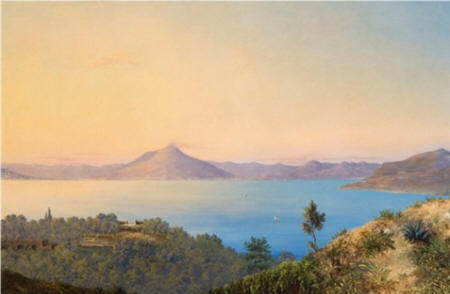

Queer Places:
Via dei Condotti, 44, 00187 Roma RM, Italy
186 Lafayette St, Salem, MA 01970
 Abigail Osgood Williams (October, 1823 - April 26, 1913) was an American
painter, together with her sister known as the Misses Williams. In Rome they
rented Louisa Lander's former studio and Mary Elizabeth taught painting to
Fidelia Bridges, and both sisters knew the Peabodys and the Hawthornes. The
sisters and their friends were part of that larger movement of New Englanders
to Italy. However, unlike for example the wealthy
Isabella Stewart Gardner,
they were from the middle class. And, like Lander, Bridges, and the many other
American women they came to know abroad, the Misses Williams were unmarried
and needed their art to be self-supporting.
Abigail Osgood Williams (October, 1823 - April 26, 1913) was an American
painter, together with her sister known as the Misses Williams. In Rome they
rented Louisa Lander's former studio and Mary Elizabeth taught painting to
Fidelia Bridges, and both sisters knew the Peabodys and the Hawthornes. The
sisters and their friends were part of that larger movement of New Englanders
to Italy. However, unlike for example the wealthy
Isabella Stewart Gardner,
they were from the middle class. And, like Lander, Bridges, and the many other
American women they came to know abroad, the Misses Williams were unmarried
and needed their art to be self-supporting.
The sisters moved to Italy in 1861 and remained abroad until 1872, returning for extended periods in the years to follow. They painted originals and copies for the tourist market, and established studios in Salem, Boston, and Rome to sell their own paintings as well as the works of other artists alongside antiquities and curios from their travels. Their brother Henry was a leading ophthalmologist who began to treat Whitney’s sister and mother for their recurrent eye problems shortly after Whitney departed for Italy.
Abigail Osgood Williams was born in Boston, Massachusetts, in October 1823 to Willard Williams and Betsey Osgood, and was the older sister and companion to Mary Elizabeth Williams. During the 1850s Abigail Williams helped run the house of her divorced brother, Dr. Henry W. Williams and his son, Charles H. Williams. Mary studied in the painting studios of Robert Conner and George Southward, and Abigail in that of her cousin Charles Osgood. In 1861, they traveled to Italy, where they resided for 18 years.
Upon arriving in Florence, the sisters immediately sought out the painter Elizabeth Adams (sister of their friend Annie Adams Fields) and the sculptor Hiram Powers for assistance with housing; through Powers they met the sculptor John Adams Jackson, who invited them to share a large apartment across from the Palazzo Pitti with him and his family. By January 1862, more comfortable with the city and their new lives, they moved to their own apartment nearby. The sisters remained in Florence until perhaps late June 1862, and by November 1862 they were settled in an apartment near the Spanish Steps in Rome.
Although primarily based in Rome during this period, Mary Elizabeth and Abigail traveled throughout Europe, visiting at some point England, Paris, Venice, and Florence. The two sisters took lessons in the Italian school of painting while in Rome, and made contact with many people of importance in the art world during this period.
Bostonian James Hubbard Weeks arrived in Rome in 1862. Weeks mentioned the Misses Williams in connection with painters Elizabeth Adams and Emma Conant Church and sculptors Florence Freeman and Emma Stebbins, and the press included others, like sculptors Harriet Hosmer and Edmonia Lewis.
In 1866 the Englishman Henry Wreford, a freelance correspondent in Italy, described the female artists in Rome collectively as “a fair constellation . . . of twelve stars of greater or lesser magnitude, who shed their soft and humanising influence on a profession which has done so much for the refinement and civilization of man.” Some of Wreford’s twelve stars, incidentally all American sculptors, are still recognizable names even today: Margaret Foley, Florence Freeman, Harriet Hosmer, Edmonia Lewis, and Emma Stebbins. Less known now are the American painter sisters Mary Elizabeth Williams and Abigail Osgood Williams, the Italian sculptor Horatia Augusta Latilla Freeman and her relative, the painter Adah Caroline Latilla, Irish painter and sculptor Jane Morgan, and English sculptor Isabel Cholmelay (her studio was at Palazzetto Sciarra). It is not entirely clear which of these women produced art of “greater magnitude” in Wreford’s mind; his discussion is rather general overall. Indeed, in his article and in others of the period, even the better-known women tend to earn more comments about their personalities, appearances, or behaviors than about their art.
In June 1867, when Anne Whitney and her companion, the painter Addy Manning, arrived in Rome, Whitney's sister, Sarah, wrote to ask if Anne had met the sisters. The four women quickly grew close. They even traveled together to the Alps in 1869, although the intrepid sisters continued on their own from Linz to Ancona, partly by boat on the Danube.
Upon their return to the United States, Mary Elizabeth and Abigail resided on Lafayette Street in Salem, where they ran a gallery of art in their house. They reconnected with Anne Whitney and Addy Manning, whose home on Boston's Beacon Hill was a gathering place for the cultural elite. The savvy sisters left several of their paintings with these friends for viewing, and hopefully purchase, by prominent visitors like Louisa May Alcott.
In approximately 1894, they took a trip through the Mediterranean, going up the Nile River in their own private boat, visiting Athens, the Dardanelles, and stopping at Constantinople. Mary Elizabeth died in Salem on September 15, 1902. Abigail died on April 26, 1913.
My published books: